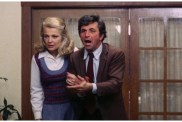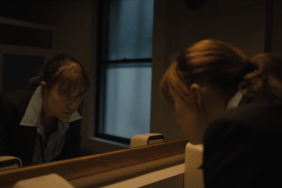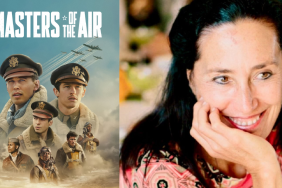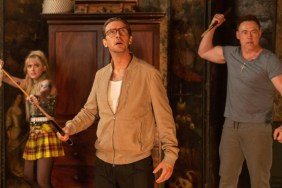Having already won an Oscar for his 2008 documentary Man on Wire, director James Marsh has slowly been evolving as a dramatic filmmaker with a series of period films released in between his acclaimed documentaries, each progressively better than the last.
With The Theory of Everything, based on the life of award-winning physicist Professor Stephen Hawking (played by Eddie Redmayne) as he struggled with the degenerative effects ALS alongside his wife Jane (Felicity Jones), it’s given Marsh a chance to raise his game, working with producers at Working Title Films, cinematographer Benoit Delhomme, composer Johann Johannsson and more.
It’s a luscious film that’s better than the usual biopic we see these days, mainly due to the strong performances from Redmayne and Jones as well as the way it shows Hawking’s story from a different angle than we’ve seen in the past.
Having mostly spoken to Marsh when his movies played Sundance, ComingSoon.net sat down with the director at a different festival, the Toronto International Film Festival, during our series of interviews for the movie when it premiered there.
ComingSoon.net: Having known your work for so long, I think this movie is another step forward for you even from “Shadow Dancer,” which was great.
James Marsh: In terms of scale of filmmaking and resources, it absolutely was and it was so welcome to have a bigger budget. I’ve always worked very efficiently on small budgets, both in documentaries and in features. Here was an opportunity to do something on a bigger scale, just cinematically. So that was a great part of this one for me, was to be able to finally express yourself visually and have the resources to do it without making these compromises that you tend to have to make for reasons of money. So that was great. I felt on this film that I finally got on screen that visual world that I had tried to do elsewhere, but the canvas of this film was big enough that I had the money to do it on this one.
CS: Did you ever work with Working Title before or was this the first time?
Marsh: No, first time, absolutely. They’re a British production company, as you know, with a great track record in successful commercial films. But they’re filmmaker friendly, and it was a very good and productive relationship with them. I really enjoyed working. They do back you and support you, so it was a good experience.
CS: I was just reading that Stephen Hawking said that the God Particle was going to destroy the universe, so I’m not sure this interview will even matter.
Marsh: Who knows?
CS: Hopefully that will happen after the movie comes out. It must be interesting to do a movie about someone who is still alive, which is very rare.
Marsh: Not with documentaries and that’s kind of been part of my experience, just working with real life stories and real people in telling you their stories, somewhat differently, because obviously it’s a dramatic screenplay. I think that it would be the best way to explore our story. It’s not a biopic of Stephen Hawking or his career, it’s a portrait of his marriage. This film felt dramatically, you’d get this idea much better through a screenplay and a dramatic film than you could through a documentary. So it felt like the right way of telling the story, which is indeed the portrait of a marriage, not a biopic of Stephen Hawking. If you go in with that idea, you’re going to be disappointed, I think. It’s actually not about Stephen’s career and his whole life story from cradle to where he is now, but it’s his marriage, and that’s very interesting territory, emotionally, and that’s one of the reasons why I was surprised by the screenplay when I read it, and thought, I’m going to do this.
CS: I think what some people might not realize going into this is that it’s based on Jane’s book.
Marsh: Exactly. It’s by two people. It’s as much about Jane as it is about Stephen. In the filmmaking, there’s an equality of point of view and perspective. She has as much screen time, if not maybe more than Stephen does. It’s interesting. She’s not a public figure the way that Stephen is, but she enables his career in ways that we show in the film to her own cost. There’s an enormous amount of self-sacrifice in her role. She’s a very strong and smart woman, too. That’s very interesting territory, again, for an actress to get at. Felicity did it so beautifully, I think, what she found to play in Jane on screen.
CS: Was it a harder sell for them to get you or was it an immediate decision for you once you read the screenplay?
Marsh: Well, I can remember exactly when I read the screenplay, I was with my wife and my in-laws and with my kids and it was Christmas. I remember saying to her, “Oh, it’s about Stephen Hawking?” so I started reading it. Then, about an hour later, I said, “This is really good. This is really interesting.” I got to the part when Jonathan arrives into the story – Jonathan, being a very charitable and lovely man who Jane meets in church, being the kind of last place Stephen Hawking wants to be. That then totally got me, when Jonathan comes into the story. I thought, “This is just fascinating. It’s more like a Bergman film than a conventional biopic or a Kieslowski movie.” That was that moment when Jonathan comes into the story is when I knew I had to do this.
CS: There’ve been other movies about Stephen Hawking, both documentaries and dramas.
Marsh: There was a movie on the BBC, which I never watched and didn’t want to watch, not because it’s good or bad, but it wouldn’t be helpful for me to see another actor and another filmmaker go at this territory, so I haven’t seen that film. There’s lots of good archives of Stephen in his earlier career, which is very useful to us, to get his voice and see how he worked with the wheelchair. We studied that obsessively, Eddie and I, to pick up any detail we could find in it.

CS: That’s one of the things I found interesting, because like I said, he’s a public figure. People know what he looks like when he’s in his wheelchair. He’s very well known.
Marsh: He’s literally an icon. He’s this hybrid between a man and a robot, with a very distinctive voice and a very distinctive kind of shape. He’s an iconic figure, a man sort of shrinking into this big chariot that he has. Again, to discover his personal life, and to allow that to be a perspective on what we do know about him, and of course, you look at his career tangently, but it’s not the focus of the story. Really, it’s this portrait of a marriage that’s at the heart of our story.
CS: I don’t think I ever realized that they met before he was struck with ALS.
Marsh: Well, there is the kind of cruel irony of life itself, that you fall in love with someone, as Jane did, and just at the moment where the illness is beginning to show itself, and her choice to stay with him and to marry him, expecting him to die within a few years is an extraordinary one in itself. Then, of course, to stick in this marriage and support him in his increasingly disabled state he finds himself and then to have three children. Amazing. What an amazing woman, really.
CS: There are a lot of powerful moments but one of the scenes that really struck me was when he had just been diagnosed and he asks the doctor how it might affect his brain. I was sick last year and I had the exact same thought as I was being treated: how is this going to affect my brain? (Not that what I was going through was anything close to ALS.)
Marsh: And of course, the answer is a chilling one. It’s like, “Well, your brain will be fine, but guess what? No one will know what you’re thinking anymore.” That’s a devastating piece of information to try and process that you’re going to be trapped without any means of communication. Of course, he even defies that one to this day. He communicates very effectively and very efficiently. But that’s chilling, that thought of being unable to communicate. That was what brought on “Project Nim,” too, that connection I made where the communication is just a big part of that story, and trying to communicate with an animal we didn’t want to communicate in the way we were asking him to. It was a nice connection to make with that particular film that I made. It’s one of many disturbing pieces of information the characters have to incorporate into their world and each other as the film and our story progresses.
CS: I know Working Title obviously has a lot of experience casting actors, so did they come up with the idea of Eddie Redmayne as Hawking?
Marsh: They were very comfortable with Eddie. They worked with Eddie on “Les Miserables.” So that helped me sell, if you like, Eddie when I was absolutely convinced he was the one. Everyone agreed he’d make a great Stephen Hawking. The issue often with films is how it works with money and trying to get a visible movie star presence in the film. That wasn’t Working Title’s emphasis, it was getting it right. So I was allowed to cast Eddie, they allowed that. That choice was supported passionately by Working Title as well, and for Steve, too. They were very, very comfortable with those choices.
CS: I think one of the nice things about Felicity is that while she’s older, she still looks very young.
Marsh: Well, they both can. They’re very, very youthful. In both cases, we aged them across 25 years, but Felicity, she passes for 18 very easily. I think she’s 29 now or 30, but this is nothing about the talent, but she’s exquisite to photograph and Benoit Delhomme studied her beforehand and lit her in ways that were incredibly interesting to get her character. She’s a very, very beautiful person to photograph.
CS: Is this the first time you worked with Benoit?
Marsh: Yes. I had seen a film he made years ago called “Cyclone.” It’s an amazing film. He made it in the early ?90s. It’s just an extraordinary piece of camerawork. I tracked his career. He worked with John Hillcoat on “The Proposition,” which is again, a pretty interesting film. So when I met Benoit, he just had some very interesting questions immediately about the story. He was really intrigued by it from a visual point of view. It was a very rich collaboration between us. We did lots and lots of thinking ahead of time with what format to use, color schemes, lenses, the use of light. He’s just a brilliant lighting cinematographer. He knows light so well. The lighting in the film is incredibly complicated. The great part of it was he does it so quickly. Dealing with lighting, it can be so fussy and frustrating and you just want to get it on with it. Benoit is so efficient and so brilliant with light, and it was a really lovely collaboration and I think we both enjoyed it immensely. We had a very strong visual idea for the film and a very clear palette for it, how we’re going to shoot it. I’m very proud of the way it looks. It was a really interesting collaboration for that film.
CS: You’ve done a lot of period films and your even your docs are very period driven, and I was curious about finding the look for it. The beginning was a little washed out, but it changes.
Marsh: Yeah, it’s the progression across the film. That was all done in camera. It wasn’t like doing it in post. Everyone says, “Did you do anything in post for that one?” We did not do that. We did everything for real – all the lighting, all the color schemes in the film, all the red light, the blue light that we’re using is all real, all done in camera. We shot on 16mm film for the sort of home movie intimate footage that punctuates the timeline of the film and takes it forward in time. That again is all shot properly in camera for real. So all the slow motion effects were done in camera for real. Benoit said, “Let’s shoot this and do it. We don’t want to do it in post. We’ll do it for real.” You commit to things and you never change them. That’s the great part of doing that, is that, guess what? We shot it that way. We were very bold in the hospital sequence. We did lots of kind of whacked out things with lenses in there and got away with it. No one knew we were doing it. We were shooting stuff that was really quite unusual for this kind of film that we’re doing, but it was a really rewarding collaboration. We’re hoping to make a film to put together next year, Benoit and I, again. It was a great collaboration. We’re going to extend that and take it further.

CS: When you do your docs, are those usually shot digitally so you can shoot a lot of footage or do you always use film as well?
Marsh: Docs, since “Man on Wire,” the interviews are so great on digital because you can shoot for hours on digital, but on film, you shoot for 10 minutes on 16mm, but both “Man on Wire” and “Project Nim” have stuff that we shot on film and I shot on super 8, so there’s a mixture of media in all of those documentaries, a mix of sort of film and digital. Digital for interviews and the film for the insert stuff to blend with archive. “Shadow Dancer” was shot on film, too. It was 35mm, which was a great choice for that movie.
CS: Another thing I had a question about was that there was a flashback rewind, and I was curious about that decision. Was that in the screenplay?
Marsh: The idea was there in one form, but I had to change it a lot as I was shooting so I shot a lot of stuff deliberately for that rewind. The discussion was finding out how to do it, and the idea being, how it came to me, was that we were going to give him back what we’ve taken away from him. We couldn’t do that in real life, but the idea was to remind ourselves the journey we’ve taken as an audience through this story, and giving Stephen back the things he’s lost and reverse time in a way that we could do this. But of course, that’s the theme in the film, the whole idea of time and its reversal and the black hole. Mathematically, I think it’s possible that time can reverse, in a mathematical sense of the black hole. So that all felt thematic, also, it was a way of ending the film, to go back to the beginning, I guess.
CS: Every time I’ve spoken to you, you’ve always had another project lined up, so is that the case now?
Marsh: This is the great virtue of my career since “Man on Wire,” is that I can go make the next one. That wasn’t the case until that film. So now I’m about to go and shoot an HBO television show in New York. I’ve just come from New York. I’d been working on that last week, and I’m going back to New York in two weeks time and I’m shooting, it’s called “Crime,” and it’s Steve Zaillian the writer and director, and Richard Price, the novelist and screenwriter, who wrote this amazing HBO show. I’m going to do one episode of that, so I’m doing that next.
CS: Have you done a lot of TV before “Man on Wire”?
Marsh: I did “Red Riding,” which is TV in the UK. It became a feature project in North America, but we’re in a great era of TV. We all know that and we hear it all the time, but for filmmakers, it’s just a godsend, to have your television writing and work to do on television, and the means to do it properly. So I’m excited. Riz Ahmed, this great young actor, a wonderful young actor, John Turturro, a wonderful actor, so I’m lucky I’m doing that in the next few weeks and I’ll be on that.
The Theory of Everything opens in New York and Los Angeles on Friday, November 7, with expansions over the next few months. Check out our interview with actor Eddie Redmayne right here and check back soon for our interview with his co-star, Felicity Jones.
The Theory of Everything
-
The Theory of Everything

-
The Theory of Everything

-
The Theory of Everything

-
The Theory of Everything

-
The Theory of Everything

-
The Theory of Everything

-
The Theory of Everything

-
The Theory of Everything

-
The Theory of Everything

-
The Theory of Everything #10










